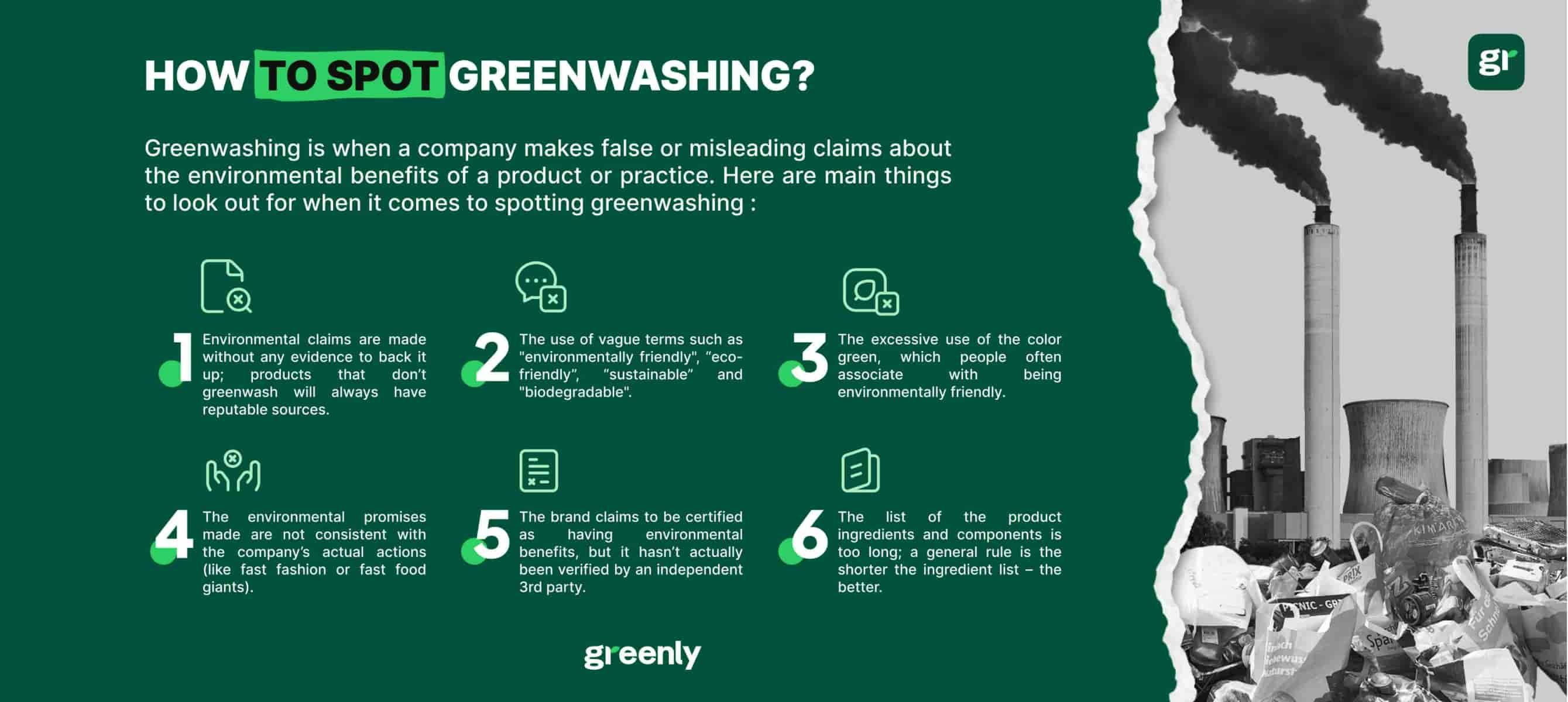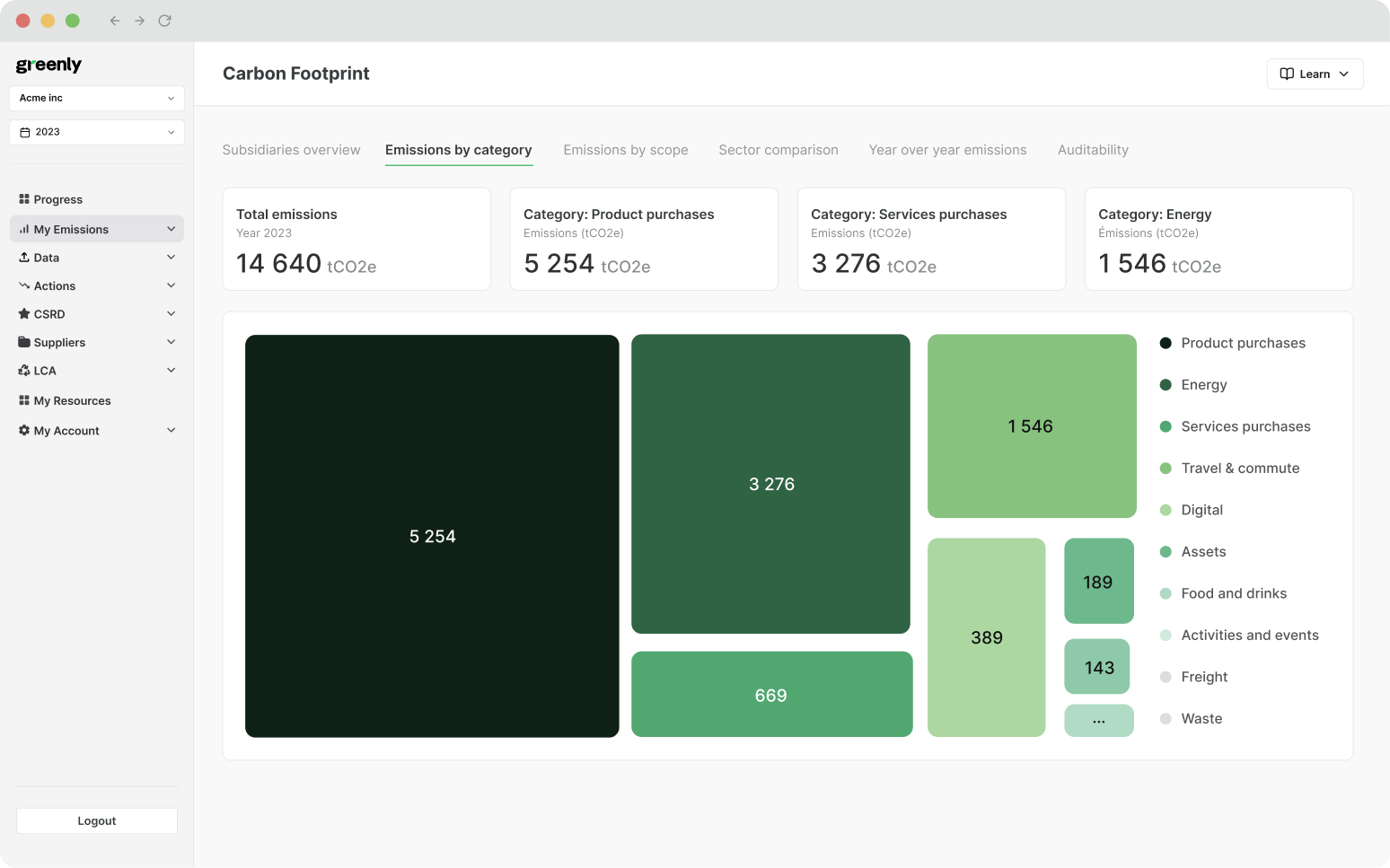
What are the 3 Pillars of Corporate Sustainability?
In this article, we'll explore what the 3 pillars of corporate responsibility are, why they're important, and how businesses can turn them into practical action.
ESG / CSR
Industries



The impact of greenwashing in our digital consumerism society
Various examples of greenwashing
Breaking down whether greenwashing can be avoided or not
You've probably heard about green products that claim to cmmit to sustainable practices, environmental benefits, and reduce greenhouse gas emissions – when in reality, these are false claims maybe false and may a sign of greenwashing.
They're all over the internet and the shelves of our stores with labels that say things like “eco friendly”, “all-natural”, “organic”, etc ... The list of environmental claims goes on. But, these terms are not always meaningful and unfortunately, most of these so-called green claims are not much more than marketing jargon.
Why have misleading environmental claims become a problem? Well, as more and more consumers become aware of the risks of climate change and try to adopt more environmentally conscious behaviours, businesses sensing opportunity are starting to jump on the green marketing bandwagon.
Unfortunately, some companies are trying to unfairly profit from the green marketing trend, and are actually making false claims. They market a product (or service) as environmentally friendly, or created using sustainable practices, but in reality these environmental marketing claims are fabricated – these false sustainability claims are otherwise known greenwashing.
In this article we'll take a closer look at what greenwashing means, why it's harmful and how companies can avoid making misleading environmental claims.
In fact, the only thing companies that fall subject to greenwashing have changed is their marketing strategy: the company uses environmental claims, to deceive their customers who are trying to be environmentally conscious and want to do their part by buying ethical products.
The main goal of greenwashing is to make profit even if it means making a false environmental marketing claim, not to actually benefit the environment in any way.
Companies that use greenwashing tactics to market their products or services are simply taking advantage of the growing consumer demand for eco-friendly products. Therefore, the sole purpose for companies who commit to greenwashing practices and unsubstantiated claims have one aim in mind – which is to sell their product or service, and green marketing helps them to achieve this goal.
Consumer trends show us that people with more green concern want to reduce their carbon footprint improve their green purchasing intentions, and overall efforts towards environmental friendliness. Customers are making an effort to commit to green living practices by changing their purchasing habits.
Instead of buying what they've always bought they're swapping out these products in favor of those with environmental benefits. Certain companies are taking advantage of this, and using it as an opportunity to sell products with an attractive environmental claim – even if it's false.
Greenwashing is obviously different from green marketing, which refers to companies that sell products or services based on legitimate environmental claims.
This is the reason why some countries now legally condemn greenwashing, in order to protect consumers and discourage companies from developing an environmental communication without strong basis.
The battle cards below will further depict some of the differences between greenwashing and green marketing:

There are several different ways in which companies greenwash, such as by failing to practice good business ethics, misleading consumers with green advertisements, failing to receive a reliable third party certification, or even by ignoring the green guidelines depicted in the Federal Trade Commission (FTC).
Here are some examples of greenwashing you should know about to ensure your company can avoid greenwashing:
Images are powerful, so powerful in fact that they can sway consumers into buying a specific product – as many people are bound to believe in environmental labeling and visual green advertising with ease as the majority of people intake information visually as opposed to green word of mouth.
A popular example of green marketing using this greenwashing tactic is when car brands shoot their car commericals in wild landscapes, as this gives the impression that the car is environmentally friendly – even though it more likely creates excess carbon emissions and contributes to global warming.
The interactive flip cards below (move cursor over card to flip) will reveal some more examples of false visual aids that could contribute to greenwashing:
The use of powerful images is one the preferred marketing techniques for companies who practice greenwashing as its an easy way to spread green lies and demonstrate seemingly-true environmental benefits and sustainability claims to intrigue customers.
Whether it's an image on a TV advertisement, in magazines, or simply on the product itself – companies use images relating to ecology, nature, animals etc. to give the impression that they're environmentally conscious, eco-friendly, or socially responsible to appeal to global consumers.

Another greenwashing technique employed by companies is to use misleading labels on products to mislead consumers. Think about it: how many times have you seen something in the supermarket that claims to have environmental benefits, or to be eco-friendly? Sadly, in a lot of cases these are false claims and the label has not been verified by a third-party who is authorised to judge the quality of the products sold.
False eco-friendly labeling could include:
Words like “eco,” “green,” or “natural” without verified certification or measurable standards.
Designs with leaves, trees, or earthy colors that imply sustainability without real evidence of impact.
Products labeled as recyclable when local recycling programs can’t process them effectively.
Suggests environmental friendliness or safety, but lacks data about production methods or sourcing.
Companies promote “carbon neutral” status based solely on offsets rather than real emissions reduction.
Highlighting small eco-initiatives while ignoring larger environmental impacts from operations.
Often these companies will declare that their product is "certified" for using natural resources, good environmental practices, net-zero, being sustainable – or whatever environmental marketing claim the company chooses to employ. Unfortunately, these assertions are false and do not prove any real signs of the company making an effort towards emissions reductions or good corporate environmentalism.
That being said, misleading labels with false environmental claims remain one of the most easily identifiable greenwashing techniques. One of the biggest clues is when the company fails to mention that the certification has been verified by a third party. Therefore, it's important to keep an eye out for a reliable third party certification on the (hopefully sustainable) packaging!


We're not talking about a fish, but about yet another greenwashing technique.
This greenwashing method works to divert the consumer's attention from potentially false green claims. The company will try to highlight a specific aspect of their product, which can be described as ethical and sustainable. However, what they're really doing is drawing the consumers attention away from aspects of the product that will create a negative environmental impact.
In other words, these brands try to capitalise on one part of their offering which has a genuine environmental claim while ignoring the other aspects of the product which are often destructive to the environment.
The vertical timeline below will reveal how a red herring could work in greenwashing:
The brand chooses a single product feature that is sustainable (e.g. recycled packaging) to talk about publicly.
Campaigns, visuals, and taglines repeat this one benefit so it becomes the main thing customers remember.
High-emitting parts of the product — materials, transport, or energy use — are kept vague or not mentioned at all.
Because the “good” part is louder, customers pay less attention to the unsustainable parts of the offer.
People walk away thinking the whole product is eco-friendly, when only one slice of it actually is.
The company leverages a real claim to distract from the rest — textbook red-herring greenwashing.
Most of the time, this technique is applied to the packaging of the product: the packaging may be made from recycled materials or it may be recyclable, but the content of the product itself has no environmental attribute, benefits or sustainable outcomes.
You sometimes hear brands claiming that their product does not contain a certain substance, which would be something worth mentioning if it actually set their product apart from the competition. However, more often than not, it's a case of green advertising – and ultimately greenwashing.
However, in cases where the ingredient or material is legally prohibited, then the product is not anymore beneficial than its competitors – as they were also prohibited from including the ingredient in their own product. Therefore, mentioning this type of "achievement" on the packaging is a case of greenwashing and has the ultimate aim of misleading consumers.
This use of approximative terminology is a common greenwashing practice. With the emergence of environmentally conscious products, many brands have decided to self-market their products as “green”. However, a lot of the time this is misleading. Companies deliberately use approximative terminology, or vague claims to lead consumers to believe that their products conform to high environmental standards.
By refraining from being too specific with the terminology used for their product's green claims, companies minimise the risk of being accused of making false claims or misleading consumers.
This is why you may often find products marked as “environmentally friendly”, a claim that is deliberately hard to confirm or deny and is more difficult to classify as perceived greenwashing.

There are several examples of greenwashing marketing tactics across various industries, such as with companies that claim to contribute to carbon offsets, work towards net-zero pledges, or false claims to working to mitigate plastic waste or the creation of sustainable products.
Here are just a few examples of common greenwashing business practices:
Many cosmetic companies promote ‘natural’ products. Unfortunately, this is often baseless and nothing more than false advertising.
One example we often see is cosmetics claiming to be “paraben and silicone free” - two harmful chemicals. The problem is that these components are sometimes replaced by other toxic substances as depicted in the table below.
| Chemical | Usage |
|---|---|
| Methylisothiazolinone (MIT) | Mainly used in shower gels and shampoos, but also in household products, paints, coatings, etc. |
| Formaldehyde Liberators | Found in conditioners, nail products, make-up, etc. They produce formaldehyde gas at the time of decomposition. |
| Phenoxyethanol | Used in various cosmetic and personal care products. |
There are many examples of false advertising in the auto industry.
Just think of the number of advertisements and marketing campaigns featuring their latest vehicle zooming across the wild or heavenly landscapes. Regardless of this visual aid which contributes to the influence of greenwashing perception, these cars do not actually respect or abide by the environmental needs of these gorgeous landscapes. In fact, more often than not, these vehicles are probably doing harm to the environment – such as by contributing to air pollution and poor energy star ratings.
Remember, a car’s carbon footprint is one of the primary sources of greenhouse gas (GHG) emissions in the world.
For instance, in 2015, the Dieselgate revealed that the Volkswagen group was using fraudulent software, which reduced particulate emissions of nitrogen oxide (NOx) and CO₂ produced by its cars during certification tests.
In 2019, H&M was accused of greenwashing on account of a collection entitled “Conscious”, purporting to offer clothing made from recycled materials.
The main problem with company's practices in fast fashion in terms false advertising is that these materials represented only a tiny part of the clothing item as a whole. In addition, the proportion of the collection was negligible compared to the overall production of the H&M brand.
Therefore, it's important to keep in mind that brands like H&M, whose collections are constantly being renewed to encourage consumption (the whole concept of fast-fashion) contributes massively to the growth of greenhouse gas emissions in the world.

Greenwashing is bad because it allows for false claims of sustainability, it encourages businesses that do nothing to prevent greenwashing to grow and mislead future consumers and stakeholders, and it continues to boost excess consumerism which is key to solving climate change.
Here are a few more reasons why greenwashing is bad for the planet, people, and even businesses:
Greenwashing isn't only a case of bad business ethics, but companies who mislead consumers or exaggerate the extent of their environmental friendliness are actually causing harm to local communities, wildlife, and the planet as a whole.
Beyond the fact that they're flat-out lying to their consumers, companies guilty of greenwashing stifle all the efforts made to reduce the environmental impact of human activity.
While many people are trying to contribute to the reduction of greenhouse gas emissions by selecting environmentally preferable products, switching to renewable energy sources, choosing a sustainable brand over their usual purchase etc. Greenwashing companies impede on all this effort and contribute to the perpetuation of an unsustainable model, responsible for irremediable damage to our ecosystem.
Remember, the Paris Agreement, which was signed in 2015 – aims to keep the world's temperature rise below 1,5 °C. This number was not chosen in a whim or a calculated as a random figure, as achieving this goal is absolutely crucial if we want to limit the catastrophic consequences of global warming.
The situation is critical, as many scientists believe that this threshold could be reached by 2030 if we don't act now – making it more important than ever before
Needless to say, there is no time to waste. This means that all actions towards tackling greenwashing or working towards building more eco-friendly practices makes a difference in the fight against climate change and greenwashing as a whole. Therefore, any initiative to undermine these valuable efforts pushes our society closer to the brink of disaster.
Be sure to check out the IPCC's synthesis published on March 20th to learn more about whey this incentive is more imperative than ever before.

Finally, if the climate emergency doesn't encourage you to start taking action against global warming and excess emissions today, know that greenwashing is a highly damaging practice for your company itself - regardless of any ecological considerations.
In fact, as consumers are becoming more and more demanding when it comes to brand transparency, and trying to fool them could be extremely costly. If your business is accused of greenwashing, you could forever loose the confidence of your prospects and customers, who are both more vigilant than ever when it comes to green marketing the environmental impact of a company.
Therefore, it is important to be careful as social media continues to become the main source of advertising for companies, as dissatisfied consumers are now able to share their experience on the web. If news of your perceived greenwashing finds its way onto the internet, your company could be tainted with a bad image. As a result, your brand identity could be damaged by greenwashing and it could prove challenging for your company to come back from this bad kind of press.
Even in the midst of the global effort to revolutionise sustainability, several companies still green wash their clients in hopes of attracting them to their product or their brand.
Here are just a few case studies of companies that have fallen subject to greenwashing their clients in recent years:
A well known example of greenwashing is with Volkswagen, who admitted to cheating their emissions tests with a prototype device – which lead consumers to believe that the devices we more the more ecological choice and low-emissions friendly than they were in reality.
Think of a food company putting false information regarding the sugars, saturated fats, and protein on a food label. This is essentially what Volkswagen did with their cars to illustrate them as environmentally friendly vehicles.
In fact, the cars were exceptionally bad for the environmental – emitting almost 40 times the given threshold for nitrogen oxide pollutants.
This is a classic case of greenwashing as Volkswagen was advertising their cars as eco-friendly in the marketing campaigns at the time, whereas in reality – Toyota was able to secure a top sales spot over Volkswagen as a result of their greenwashing scandal.
Almost everyone is familiar with Nestlé, as many of our childhood's consisted of opening the yellow, square, plastic chocolate powdered containers to make chocolate milk or even hot chocolate during the holidays.
As the company remains a staple, especially in American grocery stores, Nestlé made an effort to adhere to today's higher sustainability standards – such as by releasing a statement explaining their new goals to make their packaging recyclable or reusable by 2025.
The issue with this claim is that Nestlé lacked concrete targets on just how to make their packaging more eco-friendly in under 10 years – a challenging goal which certainly requires miniature targets to be met in between in order to ensure long-term success in the sustainability project.
Think of someone, who has no previous athletic experience, planning to run a marathon in 2 years. Clearly, this person would need to work their way up to being able to run a full marathon – implementing new exercises, foods, and various practices into their health routine to be successful later. The same goes for Nestlé trying to transition to the use of sustainable packaging.
Almost everyone has heard of the infamous, "10 cent discount" with Starbucks if drive-through customers are to provide their own cups.
In fact, the well-known global coffee chain was the first fast food chain in the U.S. to implement this tactic in an effort to scale back on the plastic waste Americans contribute due to fast food every year – which remains upwards of 50 million tonnes.
However, Starbucks has also fallen subject to greenwashing coffee lovers as a result of disingenuous efforts to use more sustainable packaging products for their drinks. This is because back in 2018, Starbucks released new lids that didn't require the use of straws. While this seemed to be the more sustainable option for customers, the truth is that these new lids had more plastic than the previous lid and straws did.
This is because the new lids were made with thicker plastic, making it even more challenging to recycle the plastic and leaving the opportunity for it to sit in landfills and contribute to excess greenhouse gas emissions.
Instead of taking accountability for this increased use of plastic, Starbucks claimed that the lids, “can be captured in recycling infrastructure” with critics that a mere 9% of the world’s plastic is recycled and that Starbucks shouldn't presume that all customers would recycle their cups anyways.
Imagine that we all decided to use private jets, but added that the majority of Americans don't use private jets anyways – so what difference does it really make?
The same goes for Starbucks. Instead of taking accountability for their plastic waste, they indirectly blamed it on the customers' failure to recycle the lids anyways.

In the US, the Federal Trade Commission (FTC) strives for protecting consumers and legally ensuring a fair marketplace. Regarding greenwashing, they created a voluntary guidelines to help people and companies in differentiating green products from greenwashed products.
These guidelines give the Federal Trade Commission the right to prosecute false and misleading claims.
Moreover, the Securities and Exchange Commission (SEC) is proposing a new rule - known as the Climate Disclosure Rule - which would force public companies to disclose their environmental impact.
This is a turning point in the US legal framework regarding environmental marketing claims, as more attention is not only being paid to green advertising – but also to the sustainability of companies' business operations.

Evidently, greenwashing isn't good for the planet or your business – but luckily, there are several different ways you can make sure that your company doesn't fall subject to greenwashing.
Here are a few protocols and practices to keep in mind when trying to avoid greenwashing:
There is no better way to backup your claims than by providing figures. Therefore, it's best to refrain from sentences such as "partially made with organic cotton". Instead, it's better to say, "Made with 20% organic cotton" – as this official claim avoids your company's practices from being too elusive.
Do not feel ashamed of your environmental performances, as long as your company making a genuine effort improve them. Remember, making an ecological transition is a long term journey that cannot be done in a split-second, especially in a world which has based its entire consumption and production model on the use of fossil fuels – making it exceptionally hard for developing countries and future generations to employ legitimacy strategies to fight against greenwashing.
Make credible claims, gain more sustainable outcomes, and less angry consumers' (or environmental groups) reactions.
This is the first and foremost step to prevent from falling subject to greenwashing. If you want to avoid greenwashing accusations or attest to your statements, simply provide evidence to back up any green claims.
For example, if your product or service has been evaluated by an approved organisation, prove it. Provide appropriate documentation to prove your green practices or the environmental attribute of your product, and be sure to make it easily accessible for your clients or any stakeholder who wants to take to a look.
The overview cards below will reveal how you can ensure your evidence is well documented to avoid greenwashing:
Support all environmental claims with measurable data that can be independently verified.
Reference certifications, third-party audits, or published reports that validate your sustainability claims.
Regularly update environmental performance data so it reflects the current status of your operations.
Explain both the strengths and the limitations of your sustainability practices — honesty builds trust.
Maintain detailed documentation for each eco-friendly statement made in marketing or product labeling.
Have your sustainability evidence reviewed by neutral experts to ensure accuracy and credibility.
In fact, if you have that evidence, it's better to share it in order to make sure your company is practicing good transparency skills and can be held accountable to your claims. In today's world, any initiative to make an organisation more transparent is generally well received by consumers and stakeholders alike who are actively searching for sustainable brands and environmentally sustainable products.
Therefore, don't hesitate to share more details even before your company is obligated to do so in a sustainability report or other required environmental endeavor – as this is almost always the best course of action for an environmentally responsible company.

The fact that you don't have any environmental or ethical certifications doesn't mean you have to hide your product. Transitioning to a more sustainable business model doesn't happen overnight as it requires organisation, planning, and an investment of both your company's time and sometimes money.
Therefore, if you need to review the composition of your product – don't expect to be able to make all the desired changes quickly, and be sure to be honest every step of the way.
What's important in this situation is that you avoid telling green lies and avoid greenwashing practices. Tell your consumers the truth! Although many of them are seeking to adopt more socially responsible patterns of consumption by purchasing green products, they are also very wary when it comes to brand transparency.
Ultimately, if your company is starting to move towards a sustainable business model – publish it! Create a section on your website that details your company's corporate social responsibility and tell your consumers all about the fact that you're taking steps to address environmental issues. This is a very positive step and consumers will respond well to the fact that you're moving ahead with more sustainable practices, and you don't have to do this part alone – Greenly can help.
Greenhouse gas emissions are not only a result of of oil companies, industrial efforts, and air pollution from cars - we all emit CO₂, and it's inevitable in line with our modern lifestyles. Remember, the greenhouse effect is a natural phenomenon, which ensures Earth's temperature is compatible with human life.
However, the excess of greenhouse gas emissions ― produced by human activities ― accentuates this phenomenon, increasing the world's average temperature and jeopardising our ecosystem.
Instead of beating ourselves up and using greenwashing practices to make our companies look better, let's focus on remedying the situation. With this in mind, there's no better way to avoid the trap of greenwashing than by practicing open communication on the subject.
This is the approach responsible companies will often choose, such as by publishing the conclusions of their personalised carbon footprint assessment as an effort to be transparent with their consumers, while adopting a constructive approach.
The objective is to identify their main sources of GHG emissions, before presenting the action plan developed, in order to reduce or offset those emissions. This display of environmental responsibility is well viewed by consumers and employees alike.
Remember, the goal isn't to be perfect. The key is action and honesty, and no greenwashing!
In many cases, the majority of a company's greenhouse gas emissions come from its Scope 3 emissions – or the indirect emissions related to its value chain.
In this context, if you want to illustrate to your customers that you are making a genuine effort to tackle your environmental impact, you should focus on your supply chain first – such as by asking for information about your suppliers' corporate environmental performance (such as their carbon assessment) and by starting to optimise your procurement strategy.
We know this is a huge task, and that's why Greenly's sustainable procurement service offers its clients to make it easy. Our experts take care of assessing their supply chains and identify opportunities to meet their decarbonisation goals.

As a reminder, carbon offsetting deals with balancing out one’s carbon footprint thanks to investments in an environmental project.
These projects, which often take place in developing countries, aim at reducing carbon emissions.
However, it is very important not to take carbon offsets as "rights to pollute". In order to be efficient, an effective carbon offsetting strategy must start with reducing the company's carbon footprint to the minimum.
In addition to this, it's important to remember that a carbon offsets' goal is only to balance a company's residual emissions – as these can't be avoided no matter how successful a company is in reducing their emissions. those they really cannot avoid.
Therefore, it is important to be really careful when advertising that your company makes use of carbon offsetting. Make sure that you properly completed a carbon assessment and started a decarbonisation process, before starting to talk about carbon offsetting.
Global warming, environmental protection and business ethics have become really sensitive topics – with your company's potential ecological transition as a whole being able to constitute as its own technical topic.
If you do not feel comfortable communicating about all of these, do not hesitate to ask for the help from an expert third-party service like Greenly.
All of Greenly's customers are offered a complete communication kit with all the required language elements in order to make communicating properly about their environmental action simple and effective.
Overall, greenwashing is bad for the planet, our surrounding communities, developing countries, and even for your business in the long-term future – making it more important than ever before to stop the greenwashing epidemic and get started in the real fight that matters, which is the one we have to fight against climate change.
If reading this article on greenwashing has made you interested in reducing your carbon emissions to further fight against climate change – Greenly can help you!
At Greenly we can help you to assess your company’s carbon footprint, and then give you the tools you need to cut down on emissions. We offer a free demo for you to better understand our platform and all that it has to offer – including assistance with boosting supplier engagement, personalised assistance, and new ways to involve your employees.
Click here to learn more about Greenly and how we can help you reduce your carbon footprint.
